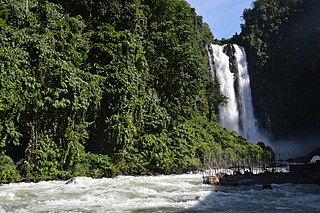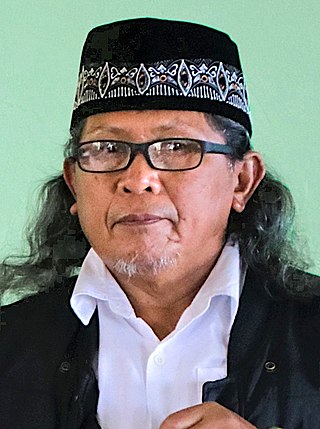Related Research Articles

Lanao del Norte, officially the Province of Lanao del Norte, is a province in the Philippines located in the Northern Mindanao region. Its capital is Tubod.

Joseph Ejercito Estrada, also known by the nickname Erap, is a Filipino politician and former actor, who served as the 13th President of the Philippines from 1998 until his removal in 2001, the 9th Vice President of the Philippines from 1992 to 1998, and the 22nd Mayor of Manila, the country's capital from 2013 to 2019, also served as the 14th Mayor of San Juan from 1969 to 1986. In 2001, he became the first chief executive in Asia to be formally impeached. At the age of 87, he is currently the oldest living former Philippine president.

Ozamiz, officially the City of Ozamiz, is a component city in the province of Misamis Occidental, Philippines. According to the 2020 census, it has a population of 140,334 people making it the most populous city in Misamis Occidental.

Kauswagan, officially the Municipality of Kauswagan, is a municipality in the province of Lanao del Norte, Philippines. According to the 2020 census, it has a population of 24,193 people.
2000 in the Philippines details events of note that happened in the Philippines in the year 2000.

The Moro conflict was an insurgency in the Mindanao region of the Philippines which involved multiple armed groups. A decades-long peace process has resulted in peace deals between the Philippine government and two major armed groups, the Moro National Liberation Front (MNLF) and the Moro Islamic Liberation Front (MILF), but other smaller armed groups continue to exist. In 2017, the peace council settled around 138 clan conflicts.
The 2006 Central Mindanao bombings were a series of three bombings and one attempted bombing in Central Mindanao on October 10 and 11. Eight people were killed and between 30 and 46 were injured.

The Mindanao bombings was a series of seemingly unrelated bomb attacks that took place on July 4, 5, and 7, 2009 in the towns of Datu Piang and Jolo, and the cities of Cotabato and Iligan in Mindanao, Philippines. The bombings killed around 7 people and injured at least 66. The Armed Forces of the Philippines has blamed several militant organizations active in Mindanao, such as the Moro Islamic Liberation Front (MILF), the Abu Sayyaf, and Jemaah Islamiyah.

Joseph Estrada began his presidency at noon on June 30, 1998, following his inauguration as the 13th president of the Philippines, succeeding Fidel Ramos. He was deposed on January 20, 2001, following the Second EDSA Revolution.

DXMSRadyo Bida is a radio station owned and operated by Notre Dame Broadcasting Corporation, the media arm of the Missionary Oblates of Mary Immaculate. Its studio is located at the newly conglomerated Oblate Media Center, Sinsuat Ave., Cotabato City, and its transmitter is located at Notre Dame Village, Cotabato City.

Abdullah Goldiano Makapaar bin Sabbar, commonly known by his nom de guerreCommander Bravo, was a former Moro rebel in the Philippines who fought under the Moro Islamic Liberation Front (MILF) as a commander.
1999 in the Philippines details events of note that happened in the Philippines in the year 1999.

Dawlah Islamiya, also called Islamic State of Lanao and formerly named as the Maute Group, is a radical Islamist group composed of former Moro Islamic Liberation Front guerrillas and foreign fighters. Based in Lanao del Sur, it was founded by brothers Abdullah and Omar Maute. The organization, which also conducted a protection racket operation in the municipality of Butig, clashes on several occasions with the Armed Forces of the Philippines, the most significant of which began in May 2017 and culminated in the siege of Marawi.

The Battle of Camp Abubakar, codenamed Operation Terminal Velocity, was the final phase of the 2000 Philippine campaign against the Moro Islamic Liberation Front which resulted in the capture of Camp Abubakar al Siddique, stronghold of the Moro Islamic Liberation Front and its largest settlement, and seat of its Shariah-based government.

The 2000 Philippine campaign against the Moro Islamic Liberation Front was a military campaign conducted by the Armed Forces of the Philippines (AFP) against a Muslim secessionist group that took place during the presidency of Joseph Estrada in the Autonomous Region in Muslim Mindanao in the Philippines. The campaign was waged "to weaken the Moro Islamic Liberation Front's capability to undermine the territorial integrity of the Philippines and inflict harm on both government personnel and civilians".
The Philippines is one of the state opponents of the militant group, Islamic State of Iraq and the Levant (ISIL), more commonly referred to by the local media as the Islamic State of Iraq and Syria (ISIS).
This is a chronology of the Moro conflict, an ongoing armed conflict in the southern Philippines between jihadist groups such as the Abu Sayyaf Group, the Maute Group, Jemaah Islamiyah, and Islamic State affiliates, mainstream separatist groups such as the Moro Islamic Liberation Front (MILF), the Moro National Liberation Front (MNLF) and the Bangsamoro Islamic Freedom Fighters (BIFF), and the Philippine Government since 1971. Much of the fighting has been concentrated on the island of Mindanao and the Sulu archipelago, with spillover incidents and attacks occurring in the Philippine capital Manila and neighboring countries such as Malaysia.
Laurence M. Narag, Sr. was an enlisted Marine of the Philippine Marine Corps and a posthumous recipient of the Philippines' highest military award for courage, the Medal of Valor. Corporal Narag served as a radioman with 61st Marine Company, Force Reconnaissance Battalion during the 2000 Philippine campaign against the Moro Islamic Liberation Front. During a military operation in Kauswagan, Lanao del Norte, Narag conducted reconnaissance on an entrenched MILF position but was detected and drew sniper fire. He was eventually wounded but managed to establish contact with a Philippine Air Force OV-10 Bronco and was able to coordinate close air support. A hospital corpsman, Corporal Ernesto Layaguin attempted to come to his aid but was himself wounded and eventually hit by sniper fire that caused his death. Narag continued firing at the enemy and coordinating air strikes despite his wounds. His commanding officer eventually had to drag him to a medevac vehicle for evacuation. Narag died of wounds later in a hospital.
Ernesto A. Layaguin was an enlisted hospital corpsman of the Philippine Marine Corps and a posthumous recipient of the Philippines' highest military award for courage, the Medal of Valor. Corporal Layaguin served with the 61st Marine Company during the 2000 Philippine campaign against the Moro Islamic Liberation Front. During a military operation in Kauswagan, Lanao del Norte, Layaguin attempted to come to the aid of a fellow Marine Corporal Laurence Narag Sr., who had conducted reconnaissance on an entrenched MILF position but was detected and drew sniper fire. Narag was eventually wounded but managed to establish contact with a Philippine Air Force OV-10 Bronco and was able to coordinate close air support. Layaguin attempted to come to his aid but was himself wounded and eventually hit by sniper fire that caused his death. Narag was eventually evacuated but died of his wounds in a hospital.
References
- 1 2 "Mindanao bombs: over 300 killed in 12 yrs". Rappler. Retrieved 2018-07-19.
- 1 2 "44 die in Philippines bus bombs". Irish Times. 26 February 2000. Retrieved 4 August 2018.
- ↑ "Bomb Aboard Bus Kills 26 in Philippines". Los Angeles Times . Archived from the original on 2012-10-23. Retrieved 2018-07-19.
- 1 2 "Barge blast death toll rises to 44 | Philstar.com". philstar.com. Retrieved 2018-07-19.
- 1 2 "Bomb blasts on ferry kill at least 32". Deseret News. 2024-01-19. Retrieved 2024-06-18.
- ↑ Cruz, Lino De La. "Victims of Ozamis ship blast still cry for justice". Philstar.com. Retrieved 2024-06-18.
- ↑ Estrada, Joseph (July 24, 2000). Third State of the Nation Address (Speech). Third State of the Nation Address. Batasang Pambansa Complex, Quezon City.
True to form, the MILF took advantage of the 1997 ceasefire to commit at least 227 violations. These include the kidnapping of Father Luciano Benedetti in September 1998; the occupying and setting on fire of the municipal hall of Talayan, Maguindanao; the takeover of the Kauswagan Municipal Hall; the bombing of the Lady of Mediatrix boat at Ozamiz City; and the takeover of the Narciso Ramos Highway.
- ↑ Nathaniel Melican (27 January 2015). "Estrada Stands by All-Out War Strategy vs MILF". Inquirer.Net. Retrieved 4 August 2018.